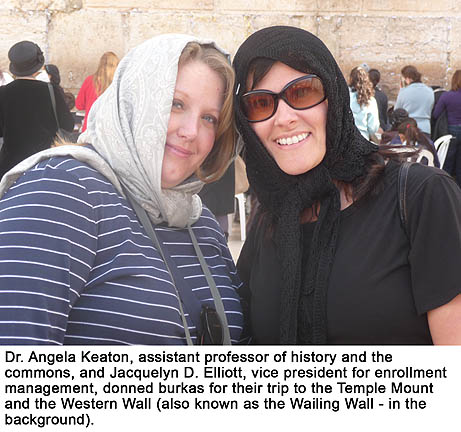 A Tusculum College vice president and professor brought back new insights about the Holy Land from a recent trip to the Middle East as well as ideas of how similar trips can be planned for Tusculum students in the future.
A Tusculum College vice president and professor brought back new insights about the Holy Land from a recent trip to the Middle East as well as ideas of how similar trips can be planned for Tusculum students in the future.
Jacquelyn D. Elliott, vice president for enrollment management, and Dr. Angela Keaton, assistant professor of history and the commons, spent three and a half weeks earlier this year in Israel and Jordan visiting Biblical, historical and religious sites, such as the Church of the Nativity in Bethlehem, the Dome of the Rock mosque in Jerusalem and Petra in Jordan. The two gave a presentation about their trip on March 24.
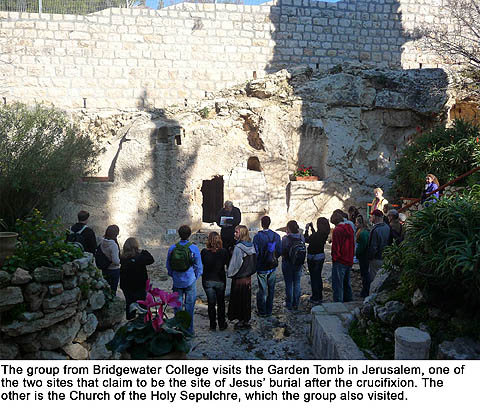 The two were “podded” with a class from Bridgewater College during the trip. Elliott explained that “podding” is a new concept whereby faculty or staff from a college or university participate in an international trip of another institution to learn about the logistics of planning such a trip and how it can be integrated academically into a course or program.
The two were “podded” with a class from Bridgewater College during the trip. Elliott explained that “podding” is a new concept whereby faculty or staff from a college or university participate in an international trip of another institution to learn about the logistics of planning such a trip and how it can be integrated academically into a course or program.
Elliott, who previously worked at Bridgewater College, said that college’s chaplain contacted her about the trip because it seemed to fit Tusculum’s curriculum and mission.
During the trip, Elliott and Keaton did the same coursework as the 15 students in the Bridgewater class, completing daily readings from the Bible and other texts as well as written assignments and journaling.
The trip’s fast-paced itinerary, which included as many as five sites a day, featured many of the sites in the Holy Land associated with Jesus’ life and ministry.
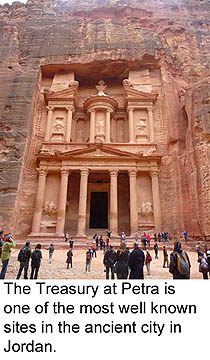 Visiting the Church of the Annunciation in Nazareth, the group was also able to see the remains of a home from the 1st Century recently discovered by archeologists. “We were very lucky to have a glimpse of it,” Elliott said.
Visiting the Church of the Annunciation in Nazareth, the group was also able to see the remains of a home from the 1st Century recently discovered by archeologists. “We were very lucky to have a glimpse of it,” Elliott said.
The Church of the Annunciation, built on the alleged location where Gabriel appeared to Mary, is representative of many of the sites in the Holy Land whose claim to be a Biblically related site cannot be positively verified, Keaton explained.
The church is also representative in that it marks a notable Biblical site. “You know you have found a significant site if there is a church built on top of it,” Keaton said. “Churches were built on everything whether the site was legitimate or not.”
One of the legitimate sites that the group visited was the House of St. Peter, a church built over what is believed to be the dwelling of the apostle. Archeologists consider this a legitimate site, Keaton explained, because the house dates back to the 1st century, fish hooks were found and graffiti had been written on the walls indicating that Jesus had been there.
During the trip, Elliott and Keaton said they discovered that some of the common western perceptions of Bible stories differ from what conditions were like in Jesus’ time. For example, Elliott said, there is common perception that Mary and Joseph were alone when Jesus was born, but in the Jewish culture of the time, they were probably surrounded by people to help, especially since many others would have returned to Bethlehem for the census.
The class crossed over into Jordan for a few days. They visited the Jordan River, which now flows at about 10 percent of what it did in Jesus’ time, Keaton noted. One of several small lagoons off the main flow of the river was probably the location of Jesus’ baptism by John, she added.
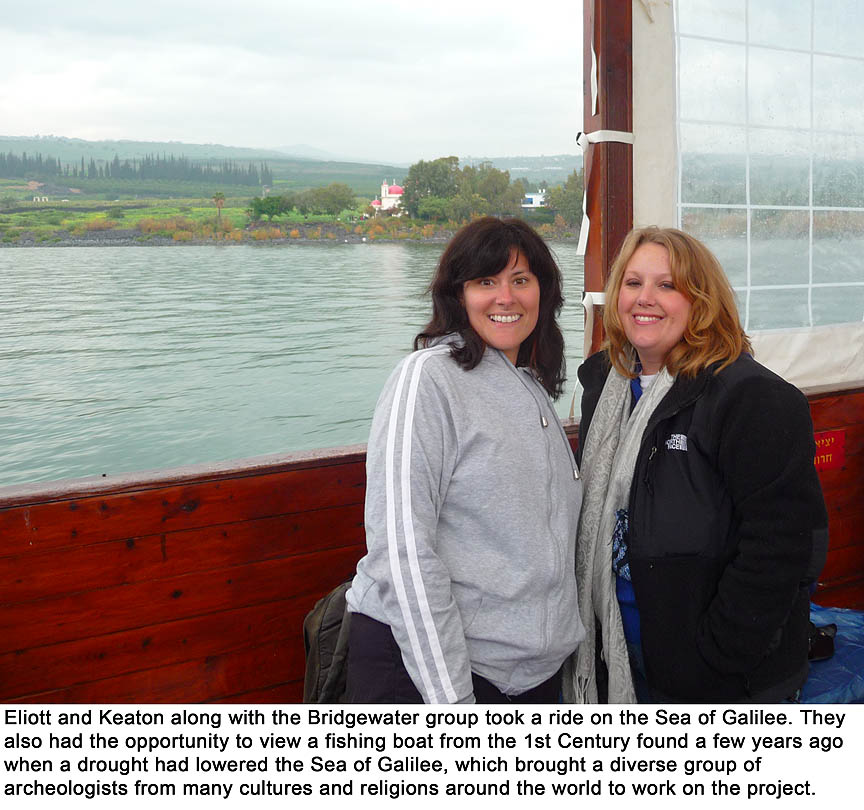 In visiting Jordan, Elliott said they noted the difference in resources between that nation and Israel to preserve and maintain the historical sites. In visiting Jericho, the ancient remains are “literally melting” because they are made of mud-brick, Keaton added. The city of Petra, another popular site for tourists, is also suffering a similar fate as it is slowly eroding from the elements.
In visiting Jordan, Elliott said they noted the difference in resources between that nation and Israel to preserve and maintain the historical sites. In visiting Jericho, the ancient remains are “literally melting” because they are made of mud-brick, Keaton added. The city of Petra, another popular site for tourists, is also suffering a similar fate as it is slowly eroding from the elements.
In addition to the fast-paced itinerary, it was also a challenge to keep names straight. “Everything there has multiple names,” Elliott explained. But, there was not a language barrier, she continued, as all signs were written in English, Arabic and Hebrew.
Jerusalem presented a challenge as well. “One of the most difficult things was keeping the chronology straight,” Keaton said. “You have the Canaanites, Philistines, Assyrians, Babylonians, Israelis, Romans, Byzantines, Arabs, Crusaders, Arabs again, Turks, British, Jordanians and then modern Israel all stacked on top of each other.”
In Jerusalem, Elliott and Keaton spent time in the Arab market, Jewish quarter and Armenian quarter. During their free time, the two had the opportunity to talk to people in the different areas, all of whom were warm and open.
While in Palestinian-controlled areas, Elliott recalled, she asked some direct questions about what the people there thought about America. “They said they loved Americans, but were not quite as sure about the American government,” she said. Keaton added that in Jerusalem they were told by people that they “wished that Americans were not so shallow – that they would read a book now and then.”
Visiting the Mount of Olives, the class discovered that adjacent to an Arab settlement, but Elliott and Keaton noted that in walking the streets in the settlement, called Silwan Village, they encountered no problems and that the people groups are not as separated as a westerner might perceive from watching media reports.
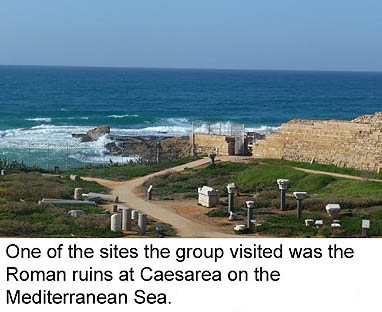 The Church of All Nations is built adjacent to the Garden of Gethsemane on the rock on which Jesus prayed. It is believed that Jesus most likely was in the garden there, Keaton said, because of the age of the olive trees around the church. The olive trees are old enough to be from the 1st Century and are the only ones of age preserved in the garden, she further explained.
The Church of All Nations is built adjacent to the Garden of Gethsemane on the rock on which Jesus prayed. It is believed that Jesus most likely was in the garden there, Keaton said, because of the age of the olive trees around the church. The olive trees are old enough to be from the 1st Century and are the only ones of age preserved in the garden, she further explained.
The class also visited the Temple Mount, regarded as one of the most holy sites in Jerusalem by both Jews and Muslims. The Temple Mount is revered by Jews as the location of Solomon’s temple and later Herod’s temple. It is now the site of two mosques, the Dome of the Rock and the al-Aqsa Mosque, and is considered the third holiest site in Islam.
The class was not permitted to go into either mosque. “The only Christian to go into the Dome of the Rock was the individual who did the tile work,” Elliott noted.
The group visited the Wailing Wall, the western wall of the Temple Mount. “It was one of my favorite places,” Keaton said. “It is important to Jews because the wall was the closest to the Holiest of Holies in the temple. The Jews believe that it is as close as they can get to the Holiest of Holies.”
The group waited in line for 15 minutes to approach the wall. “You could literally feel the movement and rhythm from the sound of all the people praying,” Elliott said. “It was a very interesting experience to see how dedicated they are to prayer.”
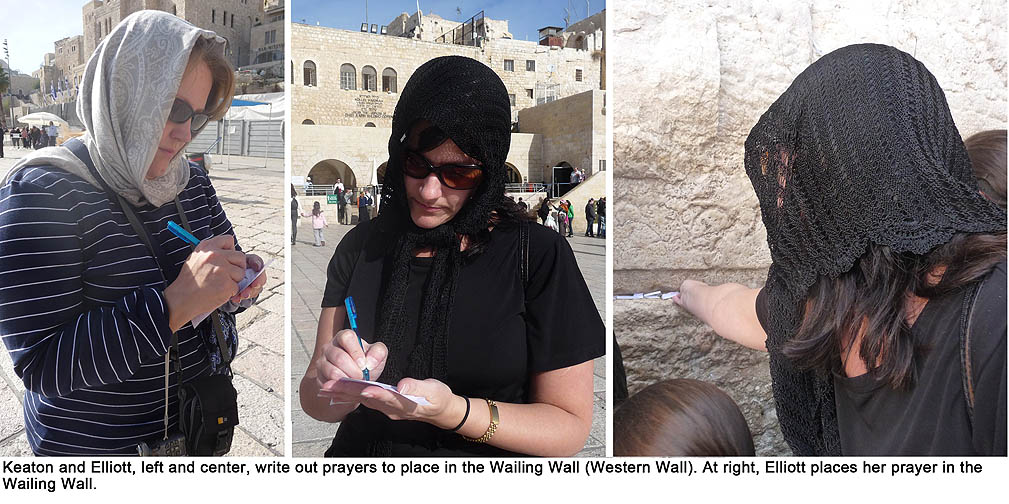 Asked about the mix of the old world and modern, Keaton said conditions depended on where you were – the group encountered everything from Bedouin camps to skyscrapers. “At one point, we saw a Bedouin boy riding a donkey with an iPod,” she said. “Everybody had cell phones. In Jerusalem, you can travel to the remnants of the ancient city of David, but nearby find a modern mall with Abercrombie & Fitch.”
Asked about the mix of the old world and modern, Keaton said conditions depended on where you were – the group encountered everything from Bedouin camps to skyscrapers. “At one point, we saw a Bedouin boy riding a donkey with an iPod,” she said. “Everybody had cell phones. In Jerusalem, you can travel to the remnants of the ancient city of David, but nearby find a modern mall with Abercrombie & Fitch.”
To a question about how the trip had affected her faith, Elliott responded that reading Scriptures is different now as she can picture the places she has visited while reading about them in the Bible. “I have a much deeper appreciation and a better understanding,” she said.
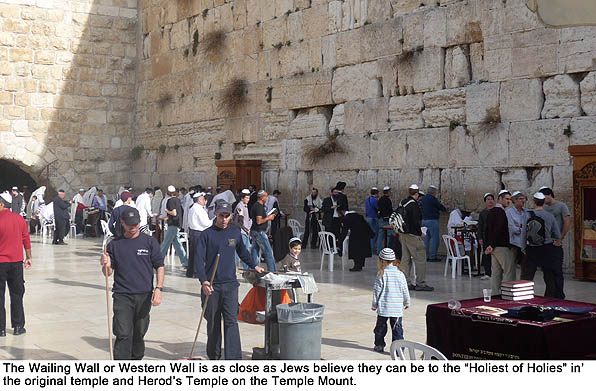 Keaton said she appreciated the academic-side of the trip, which introduced questions about the Bible and men’s religious traditions. “When you keep questioning, searching and pondering, there is always something to learn,” she said. “You also need to remember that questioning does not mean rejection of a belief.”
Keaton said she appreciated the academic-side of the trip, which introduced questions about the Bible and men’s religious traditions. “When you keep questioning, searching and pondering, there is always something to learn,” she said. “You also need to remember that questioning does not mean rejection of a belief.”
The two said a similar trip would be a fit for Tusculum’s curriculum and students, and an itinerary could be determined to match what a particular class was studying or wanted to see.


